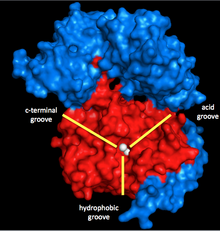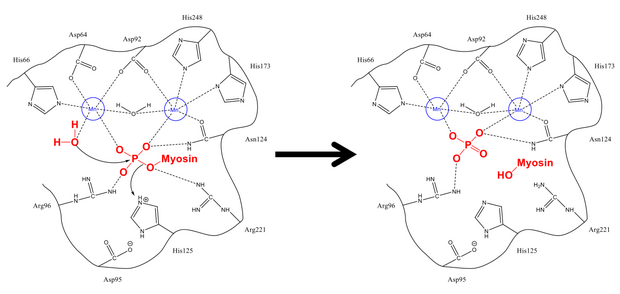Myosin-light-chain phosphatase
| Myosin Light-Chain Phosphatase | |||||||||
|---|---|---|---|---|---|---|---|---|---|
ExPASy NiceZyme view | | ||||||||
| KEGG | KEGG entry | ||||||||
| MetaCyc | metabolic pathway | ||||||||
| PRIAM | profile | ||||||||
| PDB structures | RCSB PDB PDBe PDBsum | ||||||||
| Gene Ontology | AmiGO / QuickGO | ||||||||
| |||||||||
Myosin light-chain phosphatase, also called myosin phosphatase (EC 3.1.3.53; systematic name [myosin-light-chain]-phosphate phosphohydrolase), is an enzyme (specifically a serine/threonine-specific protein phosphatase) that dephosphorylates the regulatory light chain of myosin II:
- [myosin light-chain] phosphate + H2O = [myosin light-chain] + phosphate
This dephosphorylation reaction occurs in
Function
Smooth muscle tissue is mostly made of
When myosin phosphatase binds to myosin, it removes the phosphate group. Without the group, the myosin reverts to its original conformation, in which it cannot interact with the actin and hold the muscle tense, so the muscle relaxes. The muscle will remain in this relaxed position until myosin is phosphorylated by MLC kinase and undergoes a conformational change.
Structure

Myosin phosphatase is made of three subunits. The catalytic subunit, PP1, is one of the more important Ser/Thr phosphatases in eukaryotic cells, as it plays a role in glycogen metabolism, intracellular transport, protein synthesis, and cell division as well as smooth muscle contraction.[5] Because it is so important to basic cellular functions, and because there are far fewer protein phosphatases than kinases in cells,[6] PP1’s structure and function is highly conserved (though the specific isoform used in myosin phosphatase is the δ isoform, PP1δ).[7] PP1 works by using two manganese ions as catalysts for the dephosphorylation (see below).
Surrounding these ions is a Y-shaped cleft with three grooves: a hydrophobic, an acidic, and a C-terminal groove. When PP1 is not bonded to any other subunit, it is not particularly specific. However, when it bonds to the second subunit of myosin phosphatase, MYPT1 (MW ~130 kDa), this catalytic cleft changes configuration. This results in a dramatic increase in myosin specificity.[1] Thus, it is clear that MYPT1 has great regulatory power over PP1 and myosin phosphatase, even without the presence of other activators or inhibitors.
The third subunit, M20 (not to be confused with MLC20, the critical regulatory subunit of myosin), is the smallest and most mysterious subunit. Currently little is known about M20, except that it is not necessary for catalysis, as removing the subunit does not affect turnover or selectivity.[1] While some believe it could have regulatory function, nothing has been determined yet.[2]
Mechanism
The mechanism of removing the phosphate from Ser-19 is very similar to other dephosphorylation reactions in the cell, such as the activation of glycogen synthase. Myosin's regulatory subunit MLC20 binds to both the hydrophobic and acid grooves of PP1 and MYPT1, the regulatory site on myosin phosphatase.[1][8] Once in the proper configuration, both the phyosphorylated serine and a free water molecule are stabilized by the hydrogen-bonding residues in the active site, as well as the positively charged ions (which interact strongly with the negative phosphate group). His-125 (on myosin phosphatase) donates a proton to Ser-19 MLC20), and the water molecule attacks the phosphorus atom. After shuffling protons to stabilize (which happens rapidly compared to the attack on phosphorus), the phosphate and alcohol are formed, and both leave the active site.

Regulation and Human Health
The regulatory pathways of MLC kinase have been well-established, but until the late 1980s, it was assumed that myosin phosphatase was not regulated, and contraction/relaxation was entirely dependent on MLC kinase activity.
One other proposed regulatory strategy involves arachidonic acid. When arachidonic acid is added to tensed muscle tissue, the acid decreases the rate of dephosphorylation (and thus relaxation) of myosin. However, it is unclear how arachidonic acid functions as an inhibitor.[4] Two competing theories are that either arachidonic acid acts as a co-messenger in the rho-kinase cascade mentioned above, or that it binds to the c-terminal of MYPT1.[4]
When the regulatory systems of myosin phosphatase begin to fail, there can be major health consequences. Since smooth muscle is found in the respiratory, circulatory, and reproductive systems of humans (as well as other places), if the smooth muscle can no longer relax because of faulty regulation, then a wide number of problems ranging from asthma, hypertension, and erectile dysfunction can result.[4][14]
See also
- Myosin
- Myosin light-chain kinase
- Rhoa
- Rho kinase
References
Further reading
- Pato MD, Adelstein RS (1983). "Purification and characterization of a multisubunit phosphatase from turkey gizzard smooth muscle. The effect of calmodulin binding to myosin light chain kinase on dephosphorylation". J. Biol. Chem. 258 (11): 7047–54. PMID 6304072.
- Kimura K; et al. (1996). "Regulation of Myosin phosphatase by Rho and Rho-associated kinase (Rho-kinase)". Science. 273 (5272): 245–248. S2CID 37249779.
